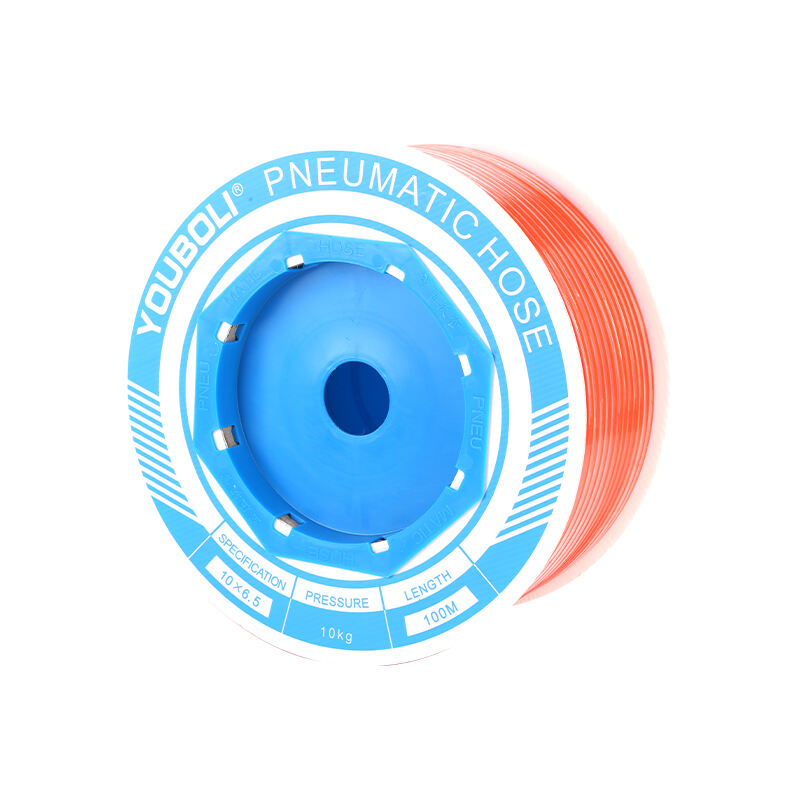Porozumění univerzálnosti řešení s TPU potrubím
Trhové plastové polyuretanové (TPU) potrubí změnilo různé odvětví díky své výjimečné kombinaci pružnosti, odolnosti a odolnosti vůči chemikáliím. Od lékařských přístrojů až po průmyslovou automatizaci, TPU potrubí slouží jako klíčová součást bezpočtu aplikací. Informovaná volba správného TPU potrubí může výrazně ovlivnit efektivitu a životnost vašich systémů.
Univerzálnost Trubka z TPU přesahuje jeho základní funkčnost. Jedinečná molekulární struktura umožňuje přizpůsobení tvrdosti, průhlednosti a výkonnostních vlastností. Ať už navrhujete lékařské vybavení vyžadující biokompatibilní materiály, nebo průmyslové zařízení s vysokou odolností proti tlaku, pochopení jemných rozdílů mezi možnostmi TPU hadic je klíčové pro úspěch.
Základní vlastnosti materiálů TPU hadic
Chemické a fyzikální charakteristiky
TPU hadice vykazují vynikající fyzikální vlastnosti, které je činí vhodnými pro různorodé aplikace. Materiál nabízí vynikající odolnost proti opotřebení, nadměrnou ohebnost a vynikající pevnost v řezu. Tyto vlastnosti zajišťují dlouhodobou spolehlivost i za náročných podmínek. Polymerní struktura TPU umožňuje udržet jeho vlastnosti v širokém rozsahu teplot, což ho činí ideálním pro provoz jak ve vysokých, tak nízkých teplotách.
Chemická odolnost TPU hadic přidává další rovinu univerzality jejich aplikacím. Vykazuje vynikající odolnost vůči olejům, tukům a mnoha běžným rozpouštědlům. Tato odolnost spolu s vlastní odolností materiálu zajišťuje, že hadice udrží svou integritu i při expozici agresivním chemikáliím nebo náročným prostředím.
Faktory mechanického výkonu
Mechanické vlastnosti TPU hadic hrají klíčovou roli pro úspěch jejich aplikace. Vynikající pevnost v tahu umožňuje hadicím odolávat vysokému tlaku bez praskání nebo deformace. Přirozená pružnost materiálu umožňuje, aby vydržel opakované ohýbání a ohyby, aniž by se objevily trhliny způsobené napětím nebo došlo k předčasnému selhání.
Další významnou mechanickou výhodou jsou paměťové vlastnosti trubičky. TPU se po prodloužení nebo stlačení dokáže vrátit do původního tvaru, čímž zajišťuje spolehlivý výkon v dynamických aplikacích. Tato vlastnost je obzvláště cenná v automatizovaných systémech, kde trubička podléhá pravidelnému pohybu nebo namáhání.
Aplikace -Specifická výběrová kritéria
Požadavky v lékařství a farmacii
V lékařských aplikacích musí TPU trubičky splňovat přísné regulační normy a požadavky na biokompatibilitu. Materiál by měl být netoxický, neaktivní a schopný odolat procesům sterilizace. Trubičky z lékařského TPU často vyžadují dodatečná osvědčení, jako je shoda s USP Class VI nebo ISO 10993.
U farmaceutických aplikací se důraz posouvá na chemickou kompatibilitu a možnost čištění. Trubička musí zachovat svou integritu při styku s různými léky a čisticími prostředky. Kromě toho materiál musí bránit růstu bakterií a musí být snadno dezinfikovatelný, aby byla zajištěna nejvyšší úroveň hygieny a bezpečnosti.
Průmyslové a výrobní požadavky
Průmyslové aplikace vyžadují TPU trubičky, které vydrží vysoký tlak, extrémní teploty a nepřetržitý provoz. Výběr materiálu by měl brát v úvahu faktory jako průtokové rychlosti, tlakové třídy a expozici chemikáliím. Průmyslové TPU trubičky často vyžadují zvýšenou odolnost proti opotřebení a schopnost udržet výkon za náročných podmínek.
Výrobní prostředí mohou vystavovat hadici olejům, chladicím kapalinám a různým průmyslovým tekutinám. Vybraná TPU hadice musí prokázat kompatibilitu s těmito látkami a zároveň zachovat svou strukturální integritu. Mělo by se také brát v úvahu ohybový poloměr hadice a odolnost proti přehnutí u složitých trasovacích požadavků.

Velikost a rozměrové specifikace
Standardní pokyny pro výběr velikosti
Výběr správné velikosti TPU hadice vyžaduje porozumění specifikacím vnitřního (ID) i vnějšího (OD) průměru. Tyto rozměry přímo ovlivňují průtokové rychlosti, tlakovou odolnost a kompatibilitu se stávajícími systémy. Standardní velikosti obvykle zahrnují mikroskopické lékařské aplikace až po větší průmyslové použití.
Tloušťka stěny představuje další kritický rozměrový aspekt. Silnější stěny zajišťují vyšší odolnost vůči tlaku a větší trvanlivost, ale mohou obětovat pružnost. Naopak tenčí stěny nabízejí větší ohebnost, ale mohou ohrozit schopnost odolávat tlaku. Nalezení optimální rovnováhy vyžaduje pečlivé vyhodnocení požadavků konkrétní aplikace.
Možnosti přizpůsobení velikosti
Když standardní velikosti nesplňují konkrétní požadavky, je nutné použít vestavěná řešení z TPU hadic. Vlastní měření umožňuje přesnou kontrolu rozměrů a tím optimální výkon ve specializovaných aplikacích. Výrobci mohou upravit vnitřní průměr, vnější průměr a tloušťku stěny, aby vytvořili hadici, která přesně odpovídá požadavkům systému.
Možnost přizpůsobit rozměry zahrnuje specializované profily a vícekomorové konfigurace. Tyto možnosti poskytují řešení pro složité aplikace vyžadující více tokových cest nebo specifické geometrické vlastnosti. Schopnost výroby na míru zajišťuje, že TPU hadice mohou splnit jedinečné požadavky aplikací a zároveň zachovat standardy výkonu.
Testování výkonu a ověřování
Protokoly kontroly kvality
Komplexní testovací protokoly zajišťují, že TPU hadice splňují stanovené požadavky na výkon. Tyto testy vyhodnocují fyzikální vlastnosti, odolnost vůči chemikáliím a dlouhodobou odolnost. Op opatření obvykle zahrnují testy tlaku při prasknutí, analýzu tažnosti a studie zrychleného stárnutí.
Pravidelná validace výrobních procesů zajišťuje konzistentní kvalitu produktu. Zahrnuje to kontrolu rozměrové přesnosti, ověření vlastností materiálu a testování výkonu za simulovaných podmínek použití. Dokumentace výsledků testů poskytuje jistotu, že hadice splní požadavky dané aplikace.
Normy dodržování předpisů
Různé aplikace vyžadují dodržování konkrétních regulačních norem. Lékařské aplikace musí splňovat předpisy FDA a mezinárodní normy pro lékařská zařízení. Průmyslové aplikace často musí splňovat specifické průmyslové normy pro bezpečnost a výkon.
Porozumění těmto regulačním požadavkům a jejich splnění zajišťuje dodržování právních předpisů a bezpečnost produktu. Výrobci by měli poskytovat dokumentaci o testování shody a udržovat aktuální certifikace svých produktů z polyurethanového trubičkového materiálu (TPU).
Nejčastější dotazy
Čím se liší TPU trubičky od jiných polymerových trubiček?
TPU trubičky se odlišují díky jedinečné kombinaci pružnosti, odolnosti a odolnosti vůči chemikáliím. Na rozdíl od jiných polymerových materiálů nabízejí vyšší odolnost proti opotřebení, vynikající pevnost v řezu a schopnost udržet své vlastnosti v širokém rozsahu teplot. Zároveň poskytují lepší odolnost proti ohýbání a lepší schopnost obnovy ve srovnání s mnoha alternativními materiály.
Jak určím správnou tloušťku stěny pro svou aplikaci?
Výběr tloušťky stěny závisí na několika faktorech, včetně provozního tlaku, požadované pružnosti a provozních podmínek. Aplikace s vyšším tlakem obvykle vyžadují silnější stěny, zatímco aplikace vyžadující maximální ohebnost mohou využít tenčí stěny. Zvažte spolupráci se výrobcem, který pomůže vyhodnotit vaše konkrétní potřeby a určit optimální tloušťku stěny.
Lze TPU hadici sterilizovat pro lékařské aplikace?
Ano, TPU hadici lze sterilizovat různými metodami, včetně autoklávu, ethylenoxidu a gama záření. Konkrétní typ TPU však musí být vybrán tak, aby byl kompatibilní s plánovanou metodou sterilizace. TPU hadice lékařské třídy jsou speciálně formulovány tak, aby odolaly opakovaným cyklům sterilizace a zároveň si zachovaly své fyzikální a mechanické vlastnosti.

